|
The TAJ MAHAL |
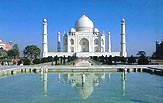
|
The TAJ MAHAL |

The fifth emperor of the Mughal Empire in its heyday, Shah Jahan (r. 1628-58), left Agra on campaign to the Deccan in 1630 at the head of the empire’s army in order to incorporate southern India into his domain. Although his beloved queen, Mumtaz Mahal, was pregnant, she accompanied her husband to the front. In the next year at Berhampur in middle India, she passed away of puerperal fever after giving birth to her 14th child at the age of 38. Mumtaz Mahal, meaning ‘the Chosen one of the Palace,’ was a nickname bestowed upon her by the former emperor, Jahangir (r. 1605-27), at the time of her marriage with Shah Jahan. She was born into a noble court family as Arjumand Banu Begum and became a good adviser to the emperor after marriage, even accompanying the emperor to the front. Shah Jahan doted on her throughout his life, accompanied by her even to the front.
When he was preceded by her in death, he ordered the entire empire to go into mourning for two years and he himself sank into irremediable deep sorrow, which lasted the rest of his life. The emperor, under the name of the ‘King of the World’ (Shah Jahan), who had been full of zeal for the expansion of the empire’s domain, only cherished the memory of Mumtaz Mahal and immersed himself in construction of her mausoleum to commemorate her eternally.
  Southern Gate of the Taj Mahal and its Chatris
The name Taj Mahal is the simplified form of Mumtaz Mahal and also means ‘Crown of Palaces.’ This mausoleum, which has been described as the fossil of an emperor’s sigh, is located near the Agra Fort, on the right bank of the Yamuna River. It took over the tradition of Mughal architecture in a symmetrical harmony, and enhanced it to its summit.
A chronicle at the time of its construction stated that its dignity and exquisiteness surpassed even the seven celestial paradises. The 17th century French doctor cum traveler, Francois Bernier, wrote that the Pyramids in Egypt are nothing but mountains of piled up stones, compared with the artistic eminence of the Taj Mahal.
Originally, there was no custom of erecting tombs in India because of the Indian belief in transmigration, that the dead regenerates after 49 days. It was after the advent of Islam that tomb architecture was brought to India. The custom took hold in India through 300 years of the Delhi Sultanate, erecting mausoleums all over India, and even Hindu Rajput tribes gradually followed it. However, it was the Mughal Dynasty that developed funeral architecture most splendidly. In contrast to the former slightly rustic forms, the Mughals built more grandiose and refined mausoleums fitting to the empire. Its precursor is the mausoleum of Humayun, the second emperor of the Mughal Dynasty, constructed in 1565 in Delhi. Humayun’s tomb, standing on a high stylobate in the center of a grand Charbagh, was built in the form of four Persian fashioned Iwans back to back and crowned with a double-shell dome finished with white marble. This resulted in the mausoleum so magnificent that almost all later Mughal tombs followed this form. It is the Taj Mahal in Agra that reaches the highest point of the development and refinement of this form.

Passing through the great southern gate of the Taj, one goes into a vast square Charbagh, beyond which is a huge platform of 100m square and 7m tall, with four slender Minarets standing at the corners. In the center of the platform soars the main building crowned with a slightly bulbous dome at the height of 65m. All of them are made entirely of white marble. Its excellent proportion and dignity has been admired by people all around the world.
brought from Persia, while a readily apparent Indian element are the Chhatris on the four diagonal sides of the main dome on the roof. It is a heavy–looking domed roof supported by slim columns, whose name is derived from a Sanskrit word ‘chattra’ meaning umbrella. A chhatri became a characteristic component for Indian Islamic architecture, and one can also see them on the top of the minarets of the Taj and smaller ones in line embellishing the southern gate. As the name of the creator of this unparalleled art work was not recorded in any formal documents, various claims have been made, for example, that the architect was Persian, Indian, or even, pleasing the rulers of colonial India, European.
However, a manuscript found in the 1930s, called the ”Diwan-i-Muhandis,” indicated that the architect of the Taj Mahal was Ustad Ahmad Lahori, who also took part in the design of the Delhi Fort.
  Looking back at the Charbagh, and Guest House Compared to former large mausoleums, there was a novelty in the design of the Taj Mahal. That is, while the former were located in the center of a charbagh divided in four by two crossing lanes with cypresses, here at the Taj, the tomb stands beyond the charbagh in a space without any disturbance, facing the rear Jamna River, against the scenery of the opposite bank. On both sides of the mausoleum were erected symmetrical sandstone buildings, facing the tomb. They are each surmounted with three white marble domes. Though the western one is a mosque and the eastern one is an assembly hall, they were essentially allotted a role accomplishing the geometric form of the garden and enhancing the main building’s exquisiteness.

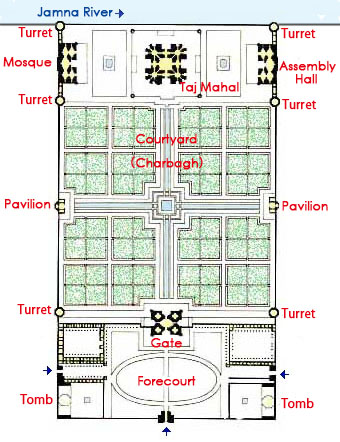
The great garden, enclosed with walls, is divided into four parts by two intersecting paths with a waterway running in the middle of each. There is a marble podium at the crossing with a pool in the center, and each part of the garden is also divided into four quarters by intersecting lanes, furthermore each quarter is divided into four portions by water channels, thus the whole garden is entirely composed of square units based on complete geometry. Those portions are well irrigated flower beds or lawns with large trees at various positions, providing cool shade. Water jets are arranged at fountains and ponds, cooling the air around them and bringing life to the scenery. What is this, if not the paradise that Emperor Shah Jahan cordially desired?
In the mausoleum, the cenotaph of Mumtaz Mahal is set in the tomb hall under a dome in the shape of a lotus. On the cenotaph is an inscription stating that she died in 1040 in the year of the Hijra Calendar (which began with the migration of Muhammad from Macca to Madina), along with 99 names of merciful god, Allah.
 
Although the French traveler, Jean-Baptiste Tavernier, wrote that Emperor Shah Jahan looked upon his vassals with father-like eyes and was more generous than any other sovereigns, he was forsaken by even his most loyal followers late in his life. He was confined by his successor Aurangzeb (r. 1658-1707) in the Mussamman Burj (Jasmine tower) in the Agra Fort and spent the last period of his life regarding Mumtaz’s mausoleum in the distance that was still under construction. It has been said that he was planning to erect his own mausoleum identical to his wife’s on the opposite side of the Yamuna River, but from black marble instead of white. However, by then the national treasure had almost run out, and so Emperor Aurangzeb only set his father’s coffin by the side of the queen’s in the underground tomb chamber of the Taj Mahal. (In "UNESCO World Heritage" vol. 5. 1997, Kodan-sha )
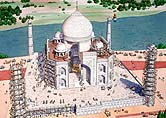
The Taj Mahal is the most popular piece of Islamic architecture in the world. Even if someone does not know the Umayyad Mosque in Syria or the Royal Mosque in Iran, he will at least know the Taj. Even if he assumes it to be a palace, not a tomb, he will be able to recall its figure. It is considered that there are the following four causes for the Taj having become so famous: The first is that the proportion of the Taj is so extraordinarily beautiful, and together with being entirely made of white marble, it emerges transcendental like a palace in a fairy tale or a celestial paradise. As a source of white marble, Kalala in Italy is world famous, exporting to Japan too, but the white marble from Kalala cannot be used outside because of its weakness in rain and acid. In contrast, as the white marble produced in Markana or Kumbaria in western India is strong enough against rain and acid, it can be used even on a dome, the part most vulnerable to corrosion. That is why white marble domes are seen only in India. At the Taj Mahal, not only the dome as the most symbolic component, but also every part from the platform to the minaret is finished with white marble. It is no wonder that Europeans were extremely surprised when they encountered such a white building, that they had never seen before. (Incidentally, there has never been an occasion on which the white marble dome of the Taj, or Humayun’s Tomb, has been polished while the Baha’i House of Worship, the Lotus Temple, in Delhi has to be polished every year, since it is entirely finished with white marble produced in Kalala in Italy.)
The second reason for the fame of the Taj Mahal is that people find attractive the romance generated by the circumstance of its construction. The fifth emperor of the Mughal Dynasty, Shah Jahan, married a daughter of a court noble, Mumtaz Mahal, and, during his life, deeply loved only her, having her bear as many as 14 children, in spite of there being many beautiful women in his harem. That is the story, as is often the case, seen also in classical music, in which people especially like an art work when there is a romance connected to its composer.

The third factor is that the characteristic of Islamic buildings is not one displaying a sculptural figure outside, but a membranous or enclosing architecture, in which the sense of beauty of an enclosed courtyard or interior space is elusive unless experienced on location. The fourth is that the sense of beauty of most people in the world is based on the aesthetics of 19th century Europe, which lays emphasis upon visual figures. Classical standards of beauty, judged by pictorial form, color, and proportion, have precedence over experiential, tactile, or speculative beauty. Even though artists in the 20th century have consciously overthrown that, the popular sense of beauty can still be said to be based on the standards of the 19th century. In comparison with even the Alhambra Palace, probably the second most famous piece of Islamic architecture, the Taj Mahal can be considered to be much more understandable.
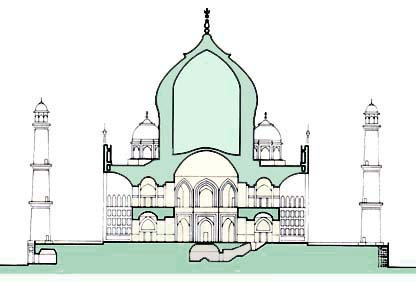
To put it in extreme terms, the Taj Mahal is an architectural work that has deviated from genuine Islamic norms and fallen into Indian vanity. For example, the dome of the Taj is a double-shelled, making both roof and ceiling domes attractive heights each, and forming a cavity-space between the double shells more gigantic than the main tomb-hall itself.
  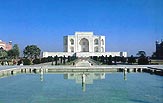
However, on the other hand, the ornamentation on its walls is all moderate; nothing deviates from the architectural composition itself. Flower and foliage scrolls, geometric patterns, and calligraphy of inlaid works, all based on white background, never jut out from the architectural frames. What wholly makes this art work is not surplus Baroque embellishment, but rather something close to the modernist architecture of functionalism and structural expressionism. Taken together, it creates a perfect beauty with dignity and chastity just like the queen enshrined here. However, as this is the world of extreme classical harmonious beauty, it can give an impression of being more a colossal craft work (an alcove ornament) than architectural, and so is occasionally given a label of boredom from people who are fond of the beauty of cacophony. |